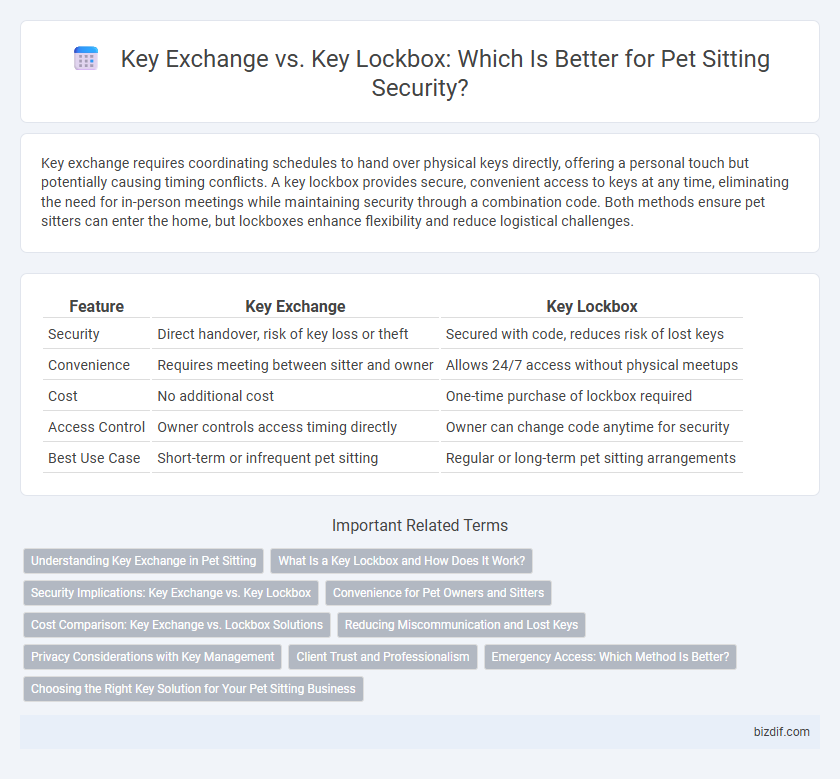Key exchange requires coordinating schedules to hand over physical keys directly, offering a personal touch but potentially causing timing conflicts. A key lockbox provides secure, convenient access to keys at any time, eliminating the need for in-person meetings while maintaining security through a combination code. Both methods ensure pet sitters can enter the home, but lockboxes enhance flexibility and reduce logistical challenges.
Table of Comparison
| Feature | Key Exchange | Key Lockbox |
|---|---|---|
| Security | Direct handover, risk of key loss or theft | Secured with code, reduces risk of lost keys |
| Convenience | Requires meeting between sitter and owner | Allows 24/7 access without physical meetups |
| Cost | No additional cost | One-time purchase of lockbox required |
| Access Control | Owner controls access timing directly | Owner can change code anytime for security |
| Best Use Case | Short-term or infrequent pet sitting | Regular or long-term pet sitting arrangements |
Understanding Key Exchange in Pet Sitting
Understanding key exchange in pet sitting involves the direct handoff of keys between the pet sitter and the pet owner, ensuring secure and immediate access to the home. This method allows for personalized communication, confirming pet care instructions and building trust. Compared to key lockboxes, key exchange reduces risks of unauthorized access but requires precise coordination and scheduling.
What Is a Key Lockbox and How Does It Work?
A key lockbox is a secure, weather-resistant container designed to store keys for pet sitting access, allowing pet sitters to retrieve keys without the owner's presence. Typically mounted near the property's entrance, it uses a combination code or electronic keypad to unlock, ensuring controlled and convenient entry. This system reduces the risk of lost or duplicated keys while providing pet owners peace of mind during pet care services.
Security Implications: Key Exchange vs. Key Lockbox
Key exchange involves physically handing over keys, which increases the risk of loss or unauthorized duplication, especially without proper verification methods. Key lockboxes use secure, coded containers that limit access through PINs or biometric controls, significantly reducing the chance of theft or misuse. Implementing a key lockbox system enhances accountability and provides audit trails, offering superior security compared to traditional key exchange methods in pet sitting arrangements.
Convenience for Pet Owners and Sitters
Key lockboxes provide pet owners and sitters with a secure, convenient way to exchange keys without meeting in person, reducing scheduling conflicts and enhancing flexibility. Pet owners can grant sitters access anytime through a combination code, eliminating the need for physical handoffs and minimizing the risk of lost keys. This streamlined method saves time for both parties and ensures reliable, easy entry to the home during pet sitting appointments.
Cost Comparison: Key Exchange vs. Lockbox Solutions
Key exchange methods often incur minimal upfront costs but can lead to higher labor expenses due to in-person handoffs and potential scheduling conflicts, making them less efficient for frequent visits. Lockbox solutions require an initial investment ranging from $30 to $100 for secure lockboxes but significantly reduce ongoing labor costs by allowing easy, self-service access for pet sitters. Over time, lockboxes offer a more cost-effective and scalable option for pet sitting services that handle multiple clients or require flexible access.
Reducing Miscommunication and Lost Keys
Choosing a key lockbox over traditional key exchange significantly reduces miscommunication and the risk of lost keys in pet sitting services. Key lockboxes provide secure, centralized access with code sharing, eliminating the need for multiple handoffs or coordination errors. This system enhances reliability and ensures pet sitters can access homes smoothly without misplacement or misunderstandings.
Privacy Considerations with Key Management
Key exchange methods in pet sitting require direct interaction, which may risk exposing physical keys to unauthorized individuals and compromise privacy. Key lockboxes offer a secure, tamper-resistant solution by restricting access through unique codes, reducing the chance of unauthorized entry. Effective key management protocols prioritize encryption, access logs, and code rotation to maintain strict privacy standards and protect pet owners' homes.
Client Trust and Professionalism
Using a key lockbox enhances client trust by providing secure, controlled access to their property without the sitter needing to meet in person, demonstrating professionalism and respect for client privacy. Key exchange requires direct interaction, which can build personal rapport but may introduce scheduling challenges and perceived risks, affecting the sitter's reliability. Employing a lockbox signals a commitment to seamless, secure service, reinforcing the sitter's professionalism and fostering client confidence in pet sitting arrangements.
Emergency Access: Which Method Is Better?
Emergency access during pet sitting is crucial, making the choice between key exchange and key lockbox significant. Key exchange provides direct control but risks delays if the sitter arrives late or the owner is unavailable. In contrast, key lockboxes offer immediate access through a secure code, ensuring faster response times and enhanced convenience during emergencies.
Choosing the Right Key Solution for Your Pet Sitting Business
Selecting the right key solution for your pet sitting business depends on factors like security, convenience, and client trust. Key exchange offers personalized handoffs but requires scheduling coordination, while a key lockbox provides 24/7 access with enhanced security features and audit trails. Evaluating your business model and client preferences ensures seamless entry management and protects pets and homes effectively.
Key exchange vs Key lockbox Infographic

 bizdif.com
bizdif.com